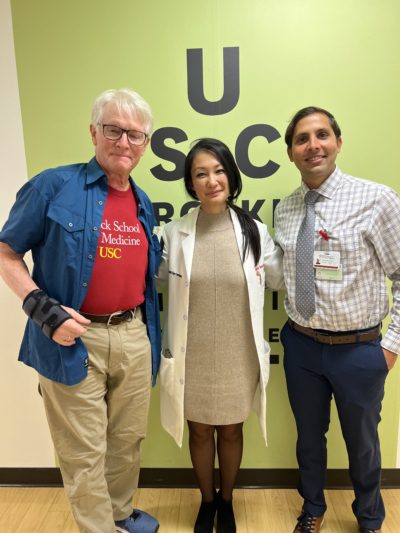A combination of strabismus and thyroid eye disease caused a patient’s vision to be deemed untreatable by multiple ophthalmologists, but a consultation with Dr. Kimberly Gokoffski offered one more chance to save his sight.
By: Eric Weintraub

Pictured (L to R): Larry Goodall, Dr. Kimberly Gokoffski, and neuro-ophthalmology fellow Dr. Frank Abella-Ayala.
When Larry Goodall was in his late 20’s, he underwent eye surgery to correct his strabismus (commonly known as a “crossed eyes” or “wall eyes”). He came out of the surgery seemingly cured and for decades experienced no complications with his eyesight. Then one day in the fall of 2020, the strabismus returned. This time worse than ever.
“My vision experience was not only seeing double,” Larry said, “but also seeing phantom objects and things that did not exist. I’d be driving and think that somebody was getting close to me on my right, when nobody was there, and I’d have to pull over. I couldn’t drive.”
Larry’s double vision made it impossible for him to drive, read, or even walk straight.
He consulted with several ophthalmologists in the Bay Area where he lives to correct his vision, but his situation grew increasingly hopeless. He underwent two eye surgeries, Botox injections, and even FDA approved Tepezza infusions to cure the double vision. Nothing worked. The ophthalmologists identified that Larry’s eye muscles had become swollen and fibrotic due to Thyroid Eye Disease (TED). Each time he woke from a surgery, the doctors announced that his eye scarring had become too severe to operate.
After over a year of trial and error, Larry’s wife discovered Dr. Kimberly Gokoffski of the USC Roski Eye Institute through an online search and learned of Dr. Gokoffski’s successful reputation for treating adults with strabismus. Traveling from the Bay Area to Los Angeles for an eye appointment was a big commitment for the Goodalls, but in January 2022, they took a leap of faith.
Dr. Gokoffski gave Larry hope from the moment he met her. “She was a trustworthy human being who was totally interested in my problem and willing to take me on with a passionate and positive attitude,” said Larry. “It was apparent from my first visit at Roski that if I was going to get my sight back, we’d hit on a capable party.”
Given Larry’s lack of success with previous surgeries, Dr. Gokoffski suggested an unorthodox treatment to re-align his eyes. “The age-old lesson is that you can only loosen muscles in patients with muscle restriction from [TED]. And I don’t mean to imply that this is wrong. It’s not. But in Mr. Goodall’s case, some of his muscles appeared spared. I explained this to him, stating that we were taking a risk by tightening some of his muscles. Knowing the potential impact on his life, we agreed it was worth trying.”
“I want to stress that along the way, I was given very accurate information as to how she was going to fix the problem,” Larry added. “This is the difference between a doctor that is working on you and a doctor that is working with you.”
The surgery was performed by Dr. Gokoffski with the assistance of neuro-ophthalmology fellow, Dr. Frank Abella-Ayala and second year resident, Dr. Austin Bohner. Dr. Abella-Ayala explains the unique approach to saving Larry’s sight: “With most people who’ve had [TED], you need to detach and relax the muscle, so the eyes go in the other direction. But in this case, we had to strengthen the muscle on the opposite side to pull the eye in the right direction.”
Almost immediately after waking from surgery, Larry discovered that his eyes were re-aligned and fusing a single image instead of double. Although his eyes took more months to heal, the improvement of his eyesight made an enormous improvement on his life. He now sees a single image and downward. His double vision only persists if he looks to the right. He can walk, drive a car, and read again.
“In neuro-ophthalmology we are often faced with complex conditions, some of which are not treatable,” said Dr. Abella-Ayala. “So, when we find these areas where we can improve and treat people, we feel tremendous satisfaction.”
“Dr. Gokoffski is an incredible doctor and human being,” added Larry. “I can’t say enough about the person behind the skill set she’s developed. It’s very meaningful in a doctor/patient relationship to trust that everyone is pulling together for a positive final result. It takes a village to help a patient. She has that village.”